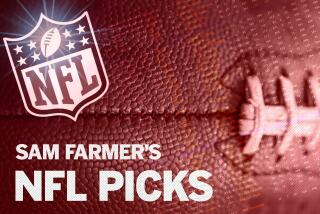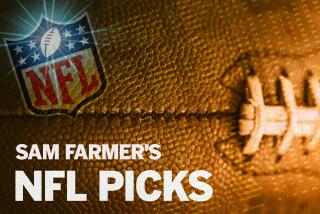Brady Bombs Broncos
Denver Coach Mike Shanahan, carefully directing a third-string quarterback, Danny Kanell, guided the Broncos to the one-point lead they carried into the last half minute Monday night at Mile High Stadium.
Then New England Coach Bill Belichick’s first-string quarterback, Tom Brady, one of the NFL’s great bomb throwers, won it, 30-26, with a deep sideline shot to young wide receiver David Givens, last year’s last-round draft choice from Notre Dame, who faked the Bronco coverage into the end zone before ducking away to catch the perfectly placed pass.
Earlier Brady bombs, measuring 48 and 66 yards, kept New England in a rousing game.
It was a rare prime-time matchup of top-level NFL strategist-philosophers, Shanahan and Belichick, both recent Super Bowl winners and both pass-offense enthusiasts. And Shanahan led at the half, 17-13, after patiently nursing the Broncos along on a 55-yard touchdown drive with Kanell’s small repertoire of passes, including very frequent throwaways.
This suggested that Shanahan might have won if he’d had his first-string quarterback, Jake Plummer, who missed the game with a broken foot. Though Plummer will likely return to lead the Broncos’ last-half-season playoff charge, the Monday nighter belonged to Belichick and his bomb-thrower.
Chiefs NFL Team of Half Year
THE PARITY SNARE, so-called, is now so all-embracing in pro football that, with few exceptions, 21st-century teams don’t open the season with nine-game winning streaks. The Kansas City Chiefs (8-0) can be one of the exceptions.
After two months of pro ball, with two months left, the Chiefs are the NFL’s Team of the Half Year. And if they win their Week 9 game against Cleveland Sunday, the Chiefs will be one step closer to the playoffs and a showdown with, possibly, the Indianapolis Colts (7-1).
They aren’t scheduled against Indianapolis in their next eight. But if it’s Chiefs vs. Colts in the AFC title game, one question is whether Chief quarterback Trent Green can hold his own with the flashier Colt quarterback, Peyton Manning.
Otherwise, these teams’ running backs are about even (though Edgerrin James is faster than Kansas City’s Priest Holmes) and the defenses are about even.
In the whole of that conference, only three other clubs have a championship chance: Tennessee (6-2), New England (7-2) and Denver (5-4). Food for thought: All three can outpass Kansas City: the Titans with Steve McNair, the Patriots with Tom Brady, and the Broncos if Plummer recovers fully from injury.
No Defense Can Rule Every NFL Minute
PRO FOOTBALL’S DEFENSIVE teams are almost all so powerful these days that most games are a struggle for even a quarterback like Peyton Manning, who is favored at Jacksonville Sunday, true, but who had to throw 37 times last Sunday, completing 23 for 266 yards, to get a 23-17 victory over new Miami quarterback Brian Griese, who was 18 for 29 for 231.
Manning moved the Colts repeatedly against Miami’s sound defensive team, covering no fewer than 65 yards on each of six drives, but could only drive them all the way twice. That matched Griese’s two-touchdown output for the Dolphins.
Actually, Griese’s big plays were more impressive than Manning’s. A well-placed Griese bomb set Miami up for a 7-0 lead in the first quarter, and in the second half his 23-yard touchdown pass to Chris Chambers was the longest of the game by anybody.
When good pro clubs get together — two dozen of them are playing this year in the 32-team NFL — that’s often the way it goes:
The league’s many superior defenses are in charge most of the time, but not — in a 60-minute game — on every play.
And when NFL offensive teams execute ideally, which happens once in a while, their many superior passers, earning or setting up a few touchdowns and field goals, can beat the great defenses.
For numerous reasons, the NFL is in balance now. But it’s a balance not of mediocrity but of good teams and good players, the best football players there are.
Bears Have a Real Quarterback
TWO OF THE bottom eight pro clubs, Chicago and Arizona — neither of which has seemed to be in a class with the NFL’s top two dozen — will, surprisingly, put two-week winning streaks on the line Sunday in two winnable games: the Bears at Detroit and the Cardinals at Pittsburgh.
The Cardinals face the tougher hurdle after doing the most in their last two games with upsets over top-24 clubs, San Francisco (in overtime), 16-13, and Cincinnati, 17-14.
Arizona’s job on the 49ers had warned Cincinnati’s plucky new coach, Marvin Lewis, who, even so, couldn’t handle the Cardinals’ new twin-threat tandem, young runner Marcel Shipp and old passer Jeff Blake. With Jon Kitna, the Bengals can match Blake, but they don’t always run well enough with aging, injured Corey Dillon and his teammates to take the pressure off Kitna.
As for the Bears, it’s possible to say they have the best players on the NFL’s eight worst clubs. Nonetheless, restricted by conservative leadership, Chicago has been all-out to win its last two from worst-eight peers, Detroit, 24-16, and San Diego, 20-7
On defense, the Bears, not so long ago, were the talk of the league. And on offense, they’re attacking at present with a real quarterback, Chris Chandler, who is a young 38, and with a power runner with speed, Anthony Thomas, who at 26 is an established good one.
Two Chicago problems are that Thomas has been injured this year and that Chandler keeps getting lost on the coaches’ depth charts. Now that Thomas and Chandler are together, it will be up to their coaches to think of a way to again topple 2-6 Detroit, which doesn’t have much but a quarterback, Joey Harrington.
49er Rattay Hasn’t Been Hit Yet
HERE ARE FOUR reasons why new San Francisco quarterback Tim Rattay might not perform as effectively every time hereafter as he did the other day when he completed a long series of nearly perfect passes to rout the St. Louis Rams, 30-10:
He isn’t big enough or strong enough to be a great pro quarterback in this era. At 6 feet and 200 pounds, Rattay can, of course, play awhile. The question is how long. The son of a coach, he looks like most coaches’ sons: studious, informed, proficient. That was enough to overthrow the Rams.
Rattay hasn’t been hit yet. On 49er pass plays, the Rams never once punished him the way the 49er defense repeatedly attacked Ram quarterback Marc Bulger, who was sacked five times and smashed continuously. The only time the Rams sacked Rattay, they took him down gently, as if he were one of theirs in a training-camp scrum.
It’s a given in pro football that every quarterback, no matter how wondrous he seems at first, is a different man after he’s been knocked around by blitzing cornerbacks or rough-and-tumble linebackers or 300-pound linemen or all of the above. It has been truly said that every pro quarterback is jumpy, that he’s never wholly free of worries that the next big hit he gets will be his last. The NFL will evaluate Rattay after he’s been hazed.
Although the Rams have seen Rattay a few times in other years, they have never been properly introduced. They don’t really know him, so, in this game, that hurt. Every quarterback is different and the Rams aren’t familiar with Rattay’s particular deportment and nuances. They know what San Francisco’s first-stringer, Jeff Garcia, can do because they’ve played against him so often. Rattay is something else.
Against the Rams, Rattay’s teammates were executing confidently and eagerly and sometimes spectacularly and hoping for the best. On the 49er team, that hasn’t always been the case this season. Something deeper than pass-offense trouble has been amiss.
Saints Tell Defenses What They’re Up To
IN NEW ORLEANS, the Saints are a top-24 NFL team with, it often seems, bottom-8 leadership. There may be another and better way to explain New Orleans’ inconsistent behavior. But when an opponent can outscore the champion Tampa Bay Buccaneers three times in a row — as the Saints have done, last year and this — it must have competent playing talent.
And every time you see them, the Saints are showing off one of the NFL’s fine quarterbacks, Aaron Brooks, as well as one of the most powerful of the game’s running backs, Deuce McAllister, who combined to upset Tampa Bay again last week, 17-14, on Brooks’ 142 passing yards and McAllister’s 110 rushing yards.
So why don’t the Saints do something like this more often? Why do they keep losing to, among others, Seattle (27-10), Carolina (twice) and Indianapolis (in a 55-21 rout)?
One explanation, I’d say, is that New Orleans Coach Jim Haslett and his offensive brain trusters don’t properly integrate their three great threats, Brooks, McAllister and Joe Horn, who, in his eighth season as an NFL receiver, continues to be underrated though he’s in his NFL prime.
The Saints, for example, on a typical offensive series, run McAllister twice. Then on third down, they put Brooks in shotgun formation to throw the ball. In other words, the New Orleans coaches are telling their opponents that 1) when Brooks is under center, they’re going to run, and 2) when Brooks is in a shotgun position, they’re going to pass. That makes it easy for any defense.
McAllister Misused in New Orleans
WHAT BILL WALSH advocated when, some time ago, he developed the West Coast offense — which most NFL teams are trying to operate today — is an integrated double threat (run and pass) on every play.
The Saints are therefore giving up one of their most threatening weapons, McAllister, whenever Brooks is in position as a shotgun passer on, say, third and five (or six or seven or even nine). For it’s much harder to get a big run after a deep handoff than after taking the ball close to the line of scrimmage.
Against an opponent playing pass defense, McAllister, with Brooks under center, could get a quick handoff and run a mile on third and anything. That’s much less likely for a shotgun ballcarrier.
The best thing about a successful running play on third and five (or nine) is that, next time, the defense must respect Brooks and McAllister both on third-down plays. Next time, the defensive coaches will reason that if they overload with blitzing pass rushers on third and long, they’ll be playing with fire. McAllister can burn them. Few NFL coaches today seem to understand that there’s a place for shotgun plays on, maybe, third and 20, but almost never on third and eight.
Bob Oates’ book, Sixty Years of Winners, is available at latimes.com/bookstore or by calling (800) 246-4042 ($16.95).
More to Read
Go beyond the scoreboard
Get the latest on L.A.'s teams in the daily Sports Report newsletter.
You may occasionally receive promotional content from the Los Angeles Times.










